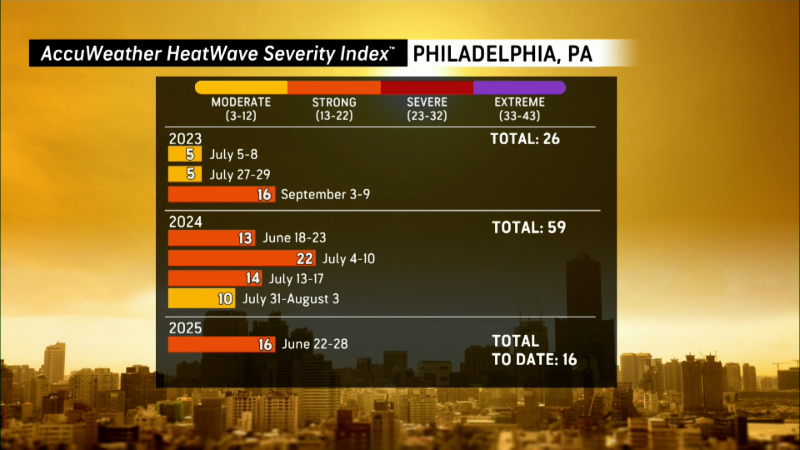Heat advisory for millions as 'dangerous' temperatures kick off summer

Millions and millions of Americans are being warned of "dangerous" heat in more than a dozen states as the summer 2025 season officially kicks off.
In parts of the Midwest and Mid-Atlantic regions more than 42 million were under extreme heat watches the morning of June 20, according to the National Weather Service. More than 37 million Americans were under heat advisories across much of the central part of the United States. Over 20 million are under extreme heat warnings.
The weather service says an extreme heat watch means residents should be prepared because conditions are favorable for an extreme heat event sometime soon. Those under a heat advisory or extreme heat warning should take action, according to the weather service. A heat advisory means there are dangerous heat conditions, while an extreme heat warning means extremely dangerous heat conditions are expected or already ongoing. You should avoid outdoor activities, drink plenty of water, take breaks in the shade and stay inside in air conditioning as much as possible.
High temperatures on June 20 are expected to range from triple digits in parts of Kansas, Nebraska and North Dakota to the low to mid-90s in the southeast and the high 80s in the Midwest and Mid-Atlantic. In some parts of the upper Midwest and Northern and Central Plains, record high minimum temperatures could be reached overnight, the weather service said.
The "significant and extremely dangerous heat wave" will last well into next week, with above-90s temperatures spreading across the eastern half of the country, the weather service said.
Heat wave to spread across US for days
The heat expected to bring temperatures into the 100s in some states on June 20 will spread eastward across much of the country in the coming days, AccuWeather forecasters said. Humidity accompanying the heat will make it feel even hotter than recorded temperatures, and overnight lows won't offer much relief in many areas, the outlet said.
The outlet estimated that 170 million Americans will experience temperatures at or above 90 degrees during this round of heat, which will last into next week. By early next week, the heat will scorch the Great Lakes, central Appalachians, mid-Atlantic and New England regions, AccuWeather reported.
Major cities including Washington, D.C., and New York, could see stretches of five to seven consecutive days with temperatures reaching 90 degrees or higher.
"The magnitude and longevity of this heat wave will be a shock to the system," AccuWeather Senior Meteorologist Chad Merrill said.
How hot will it get today? See forecast map
Power outages in Philadelphia as extreme heat looms
A round of severe thunderstorms that swept through the Mid-Atlantic on June 19 left thousands without power in the Philadelphia metro area. The storms brought down trees and power lines with winds that clocked 70 mph, according to power company PECO.
As of the morning of June 20, there were over 150,000 homes and businesses without power in Philadelphia and surrounding Bucks, Chester, Montgomery and Delaware counties, according to Paste BN's power outage tracker. PECO said about 165,000 customers had already been restored by 7 a.m. on June 20.
The outages come as Philadelphia is expected to feel the effects of the heat wave sweeping the country into next week. While the weather service there said June 20 will bring a break in the heat for the region, with a high temperature in the 80s, the break won't last. Highs will increase over the weekend, with an expected high of 91 on June 21, 95 on June 22 and 99 on June 23 before triple digits could be reached later in the week.
Heat indices, which measure how hot it really feels with factors like humidity considered, will top 100 degrees for multiple days, the weather service in Philadelphia warned.
How to stay safe in the heat
Heat is the deadliest weather hazard, according to the weather service. It killed more people in the United States in 2024 than floods, tornadoes, wind or hurricanes.
Here are some heat safety tips to keep you and your loved ones safe:
- Use sunblock or sunscreen: And reapply it regularly (every 2 hours is a good baseline.)
- Dress for the heat: Pick loose fitting, light colored and lightweight clothes, the National Weather Service recommends.
- Don't leave kids or pets in the car: The temperature quickly becomes deadly – even if it's not that hot outside.
- Check the weather: Your favorite weather app should have a wealth of information about UV index (for sunblock purposes), heat warnings and the feels-like temperature. Heat.gov has additional information about the forecast and heat risk.
- Bring water: You'll need multiple bottles of water per person if you're spending extended time out in the sun. (How many bottles? Read more here.)
- Seek shade and air conditioning: Minimize your risk by staying cool and avoiding direct sun when you can.
- Know your risks: Heat is dangerous for everyone, but some people are more vulnerable than others. Being a child, over 65 or pregnant puts you at greater risk, the Centers for Disease Control and Prevention says.
Contributing: Joel Shannon